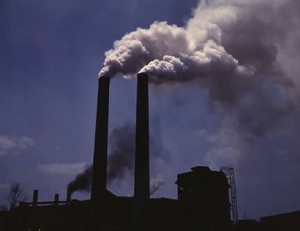
Los Angeles has the dubious distinction of having the worst short and long-term particle pollution in the nation as well as the most ozone. But that could begin to change with an extensive new plan to target greenhouse gases put forward by the Obama Administration on Wednesday.
The U.S. Environmental Protection Agency announced a milestone move to curb greenhouse emissions, just one day after a major chemical testing initiative we covered in “Chem and Get It.” But as hopeful as the new plan sounds, it seems to directly conflict with the Clean Air Act by giving smaller polluters a pass.
At the same time, a major California lumber company cashed in handsomely just a week after the state’s Governor Arnold Schwarzenegger quietly pushed through new rules that would reward the timber industry for not cutting down its trees.
The result is a murky outlook for cleaning up the nation’s toxic air and combating global warming, one complicated by an obeisant government and obstinate industry. There are certain to be many more bad air days in America.
EPA Administrator Lisa Jackson announced the new program, appropriately enough, in Los Angeles:
“By using the power and authority of the Clean Air Act, we can begin reducing emissions from the nation’s largest greenhouse gas emitting facilities without placing an undue burden on the businesses that make up the vast majority of our economy,” said EPA Administrator Jackson. “This is a common sense rule that is carefully tailored to apply to only the largest sources — those from sectors responsible for nearly 70 percent of U.S. greenhouse gas emissions sources. This rule allows us to do what the Clean Air Act does best – reduce emissions for better health, drive technology innovation for a better economy, and protect the environment for a better future – all without placing an undue burden on the businesses that make up the better part of our economy.”
That may seem like a common sense rule but it doesn’t conform with the Clean Air Act which sets the threshold 100 times lower at 250 tons. This makes the new initiative vulnerable to the inevitable court challenges that big industry is bound to set in motion making us wonder why the Administration would risk this legally while at the same time gutting the breadth of these new rules.
Republicans don’t mind, however. “It’s kind of hard to see that this will stand up in court because it does seem to fly in the face of the statute,” said Jeff Holmstead on National Public Radio yesterday. Holstead was President Bush’s EPA air pollution chief and now is a lobbyist for big businesses, like electric companies that are wary of the EPA regulating greenhouse gas emissions. “The big problem is just concern that this will delay a lot of projects that people would like to do.”
The new rules may cover the emissions of the group of six greenhouse gases that may be covered by an EPA rule controlling or limiting their emissions including carbon dioxide, methane, nitrous oxide, hydrofluorocarbons, perfluorocarbons and sulfur hexafluoride.
Jackson, however, does not seem daunted by the challenges posed by the Prevention of Significant Deterioration and Title V Greenhouse Gas Tailoring Rule:
“In the coming months, we will continue working together with regions, states and localities, as well as Congress, to put climate solutions into action. We will explore cost-effective ways to expand the reach of energy efficiency and innovation to key sectors of the economy, where opportunities are very real. In addition to the national fuel economy proposals for light-duty vehicles, we see the potential for significant emissions cuts in other transportation sectors, which together account for about 28 percent of the nation’s emissions. We are also exploring moving forward with New Source Performance Standards so that power plants, refineries, cement manufacturing and other stationary sources are using energy efficient motors and heaters – helping to spark new innovations and new ways of doing business that will ensure our economic and environmental sustainability for generations to come.
“Let me close on that last point: generations to come. Our chief responsibility in all of this is to leave our planet a better place. Whatever our political beliefs are, wherever we come from, and whatever strategy we think is best, a concern for our future generations is – ultimately – what brings us all here.”
What brings about $10 million to Sierra Pacific this week is a controversial gift care of Governor Schwarzenegger who on Wednesday began a three-day climate summit in Los Angeles. “This agreement and the partnerships formed at this summit will help people around the world reduce the 20% of global warming emissions that come from deforestation,” the governor said in a short written announcement.
Sierra Pacific Industries, California’s largest private land owner, claimed a share of that money almost immediately for, in effect, doing nothing. In a September 30 press release, the company seemed pleased:
“Elements of this transaction are unique to California; the first project in the series of activities will be designed to protect the genetic diversity and integrity of Giant Sequoia trees in the Sierra helping to expand its range as an adaptation strategy in the face of climate change. Noted for their enormous potential to sequester carbon dioxide, over 20,000 Giant Sequoias in this first project area will be conserved in perpetuity.”
[snip]
“Overall, some 60,000 acres of SPI’s private timberland in California will be dedicated to this transaction. The projects will be submitted to the Climate Action Reserve for registration in the Reserve’s registry of carbon offset credits consistent with CAR’s recently approved forest protocol; Version 3.0. The Climate Action Reserve is a national offsets program working to ensure integrity, transparency and financial value in the U.S. carbon market. The protocol was approved by the Climate Action Reserve on September 1, and endorsed by the California Air Resources Board on September 24, 2009.”
Environmentalists have cried foul over this:
“This looks a whole lot like a giant timber company getting paid millions of dollars to do business-as-usual, and destroying our forests, water quality, and wildlife in the process,” said Brian Nowicki of the Center for Biological Diversity. “Giving carbon credits for logging operations is a shell game where timber companies win, and the forest, the climate, and everyone else loses.”
The deal announced today is based on last week’s decision by the California Air Resources Board to adopt a set of protocols for assessing the carbon impacts of forest practices, including a measure that would allow forest clearcutting to qualify for carbon credits as part of California’s efforts to reduce greenhouse gas emissions. The board heard testimony from numerous conservation organizations opposed to the provision, asking the board to postpone the decision to allow time to consider the environmental impacts of the rule. However, it board voted unanimously to immediately adopt the protocols with the clearcutting provision included.
“This explains why everybody was so anxious to adopt the forest protocols last week and totally ignore the obvious problems regarding forest clearcutting,” said Nowicki. “Giving carbon credits for clearcutting calls into serious question the integrity of California’s forest carbon program and, in fact, raises serious concerns over the state’s commitment to achieving real reductions in the state’s greenhouse gas emissions.”
The response from the governor’s office was predictable. Opposition to clear-cutting “is like a religion to some folks,” Dan Pellissier, Schwarzenegger’s deputy Cabinet secretary for energy and the environment, told the Los Angeles Times. “There is no amount of science that will undercut their beliefs.”
Schwarzenegger’s condescension towards environmentalists and embrace of big business polluters, combined with a possible fatal flaw in Obama’s new greenhouse gases plan, virtually assures that Californians will have many more bad air days ahead.












Recent Comments